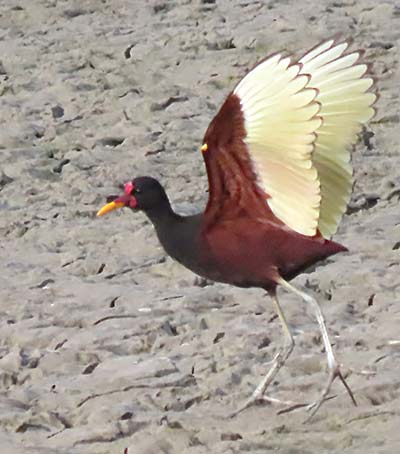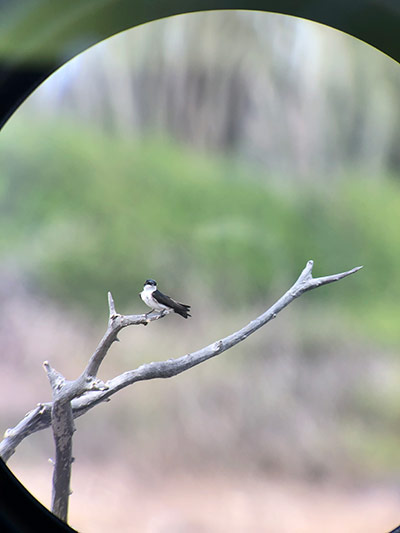A bird in the hand is worth……..not on Bonaire!
Two exceptionally rare bird sightings on Bonaire: A Wattled Jacana, and the first-ever Blue-and-white Swallow!
Posted July 17, 2021
How to find a rare bird on Bonaire!
To find rare birds on Bonaire, it’s necessary to be a part of the local birding network, as then everyone works as a team. This story exemplifies the importance of teamwork in birding.
An old adage tells us, “A bird in the hand is worth two in the bush,” meaning that one “sure thing” is better than two “maybes.”
But Bonaire, always willing to march to a different drummer, disputes that saying!
The backstory.
The story began last week on Thursday evening when my phone pinged. It was an incoming text from Rob Wellens of Curacao Backyard Birding. The text said: “Wattled Jacana observed today on Curacao! Not seen for many years!”
I immediately texted back, “WOW-WOW-WOW,” because the sighting of a Wattled Jacana is very wow-worthy. I then jokingly added, “Send it to Bonaire!”
Fast forward 24 hours, and Friday evening my phone pinged again, this time with an incoming message from birding friend, Sietse Nagelkerke: “My sister and her husband (Jolijn Nagelkerke and Lars Aalsma) found a Wattled Jacana today! Check it out!”
My immediate reaction was, “Wow, Rob sent it over!” I sent him a text, but no, “his” Wattled Jacana was still in Curacao. So there were two individuals! I immediately set my alarm for an “early-bird” birding excursion to check out Bonaire’s Wattled Jacana. This was a very exciting find for Jolijn and Lars, as they were rather newbie birders, although from a very experienced birding family, including brother, Sietse, and their father, Ad Nagelkerke.
About the Wattled Jacana.
The most noticeable feature is the red and wattled shield contrasting with a yellow bill and a black-colored head. The upper parts can be dark, or chestnut-colored. Flight feathers are yellow to pale, greenish-yellow with dark tips and a bright yellow carpel spur. The Wattled Jacana also has very elongated toes and claws, and it can even use these to distribute its weight so as to be able to walk on floating vegetation while it forages.
Prior sightings of the Wattled Jacana on Bonaire.
Primarily found in South and Central America, there is only one prior record of a live bird observed on Bonaire, recorded by the late Jerry Ligon in May 2009.
The hunt for the Wattled Jacana.
I arrived at the designated location just a few minutes after sunrise. I could immediately identify the Wattled Jacana (Jacana jacana)! It had a chestnut back which just glowed in the warm light of sunrise. It was foraging along the edges of the small pond, at ease with many other species of birds, including flamingos, Short-billed Dowitchers, gulls and terns, terrestrial birds, stilts and plovers, coots and gallinules. A Least Grebe and an American Oystercatcher were icing on the cake. But wait–what was that? There’s a bird flying low over the pond! What is it!!!???
Bank Swallow or Blue-and-white Swallow, that is the question!
The bird that was working the pond appeared to be a swallow, which, at this time of year on Bonaire, is unusual. It wasn’t a Barn Swallow–the most common swallow observed here–so was it a Bank Swallow? That would be a nice sighting at any time of year but would be of particular interest in the summer months when swallows are no longer passing through on their migrations.
I ran an image through Merlin Bird ID to see what it had to say. With eyebrows raised and a burgeoning smile, I read that it was showing as a Blue-and-white Swallow.
“Nah,” I decided, “it can’t be! What would be the chances of two extremely rare birds being seen the same day in the same pond?” I returned my focus to the guest of honor, the Wattled Jacana.
It was only a few hours later, in a conversation with Sietse, that I mentioned the Bank Swallow. He said, “that is no Bank Swallow! It’s a Blue-and-white Swallow!”
It seems the bird perched when Sietse was there a bit later than I, and he was able to get some images of it using digiscoping, a way of capturing an image through a spotting scope. When viewed on its perch, it certainly did appear to be a perfect match for a Blue-and-white Swallow!
The excitement built as we realized the magnitude of what we saw! A Blue-and-white Swallow has never before been observed or officially recorded on Bonaire, or on Aruba or Curacao as well. The ABC islands often “share” birds species, but it looked like Bonaire was to have the honor of the first visit from a Blue-and-white Swallow. However, before I could celebrate, I had to get the sighting confirmed. Luckily, the eBird reviewer was able to confirm the sightings of both the Wattled Jacana and the Blue-and-white Swallow. The swallow brought Bonaire’s species count to 241!
About the Blue-and-white Swallow.
The Blue-and-white Swallow is a small swallow that is named for its appearance. Steel-blue upper parts are glossy, while its wings and tail are darker with steel-blue margins. Underparts are white with grayish sides and flanks. The tail is short and slightly forked.
The Blue-and-white Swallow that we observed belonged to the subspecies patagonica (Pygochelidon cyanoleuca patagonica), and is an austral migrant from South America.
These austral migrants are species of birds that breed in the more temperate areas of South America but migrate north towards the Amazon region for the southern hemisphere’s winter (summer for Bonaire). It appears this individual overshot the Amazon region.
The moral of the story is twofold.
First, never, ever settle for a bird in the hand. ALWAYS seek out the two birds in the bush. They may be rare birds, just like our Wattled Jacana and Blue-and-white Swallow!
Secondly, always listen to newbie birders. They might not always know what they are observing, but they bird with “fresh eyes.” If Jolijn and Lars had not observed and identified the Wattled Jacana and reported it to Sietse, then the visit of the Wattled Jacana might have gone unnoticed, and, subsequently, it’s quite possible that the Blue-and-white Swallow’s first visit to Bonaire and the ABC islands might never have been documented! Teamwork!
Images courtesy of the author and Sietse Nagelkerke.
About the author:
 Susan has been living on Bonaire for over 30 years. She is a certified bird guide, as well as a topside and underwater photographer. She is a 2016 graduate of the Caribbean Birding Trail Interpretive Guide Course conducted by BirdsCaribbean.
Susan has been living on Bonaire for over 30 years. She is a certified bird guide, as well as a topside and underwater photographer. She is a 2016 graduate of the Caribbean Birding Trail Interpretive Guide Course conducted by BirdsCaribbean.
Get in touch with Susan
Contact Susan via email, Facebook Messenger, call Susan or use the online form below.
If you have any questions about your Bonaire birding tour, feel free to contact Susan for answers. She is always willing to go into more detail about routes or the best times for a tour based on your personal preferences. Tours can be tailored to your interests, whether that be birds, photography, or both!
It is also a good idea to do some homework on the birds of Bonaire before you come. Knowing a little about the birds you might encounter on your tour will make your experience even more enjoyable!
Be sure to check out these resources for birding on Bonaire. Also, reading the Bird Blog will introduce you to the birds that might be observed on Bonaire.
Get In Touch
Get in touch with Susan to check availability for the dates you are visiting Bonaire.
Consent: By using this form you agree with the storage and handling of your data by this website.






